Chinese Buddhist Art Gallery
Find Your Chinese Buddha Statue
Mytheast's Chinese Buddha Statue
Mytheast treats Buddha statue as artwork and the symbol of goodness but not only merchandise.
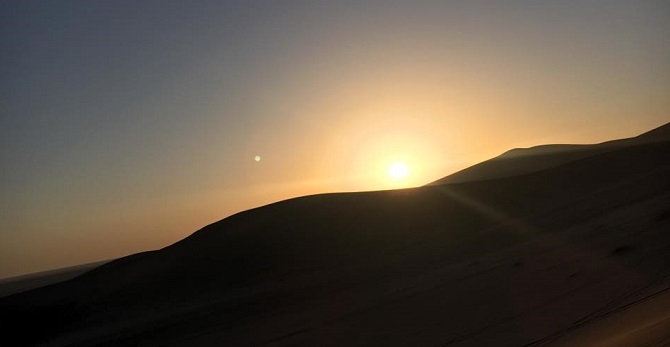
History of Chinese Buddhism/ Han Buddhism:
Two Thousand Years
Buddhism was introduced to China in The Han Dynasty (202 BC - 220 AD). The Buddhist art, such as Buddha statue, was gradually introduced to the four counties in Hexi: Dunhuang, Zhangye, Wuwei, Jiuquan (河西四郡: 敦煌, 張掖, 武威, 酒泉), and the mainland of China from the Greater Yuezhi (大月氏) in the 2nd century.
Chinese Buddhism has a long history and traditional Chinese Buddhist art is awesome, you can find many amazing Buddha statues, murals, painting, Buddhist caves and Buddhism history in China. Those are the important parts of East Asian Buddhist art culture. Especially Buddha statue, this is the most well-known artwork to come out of Chinese Buddhist art.
About Chinese Buddha Statue
After Buddhism was introduced to China, it formed 3 schools: Han Buddhism, Theravada Buddhism, and Tibetan Buddhism. Buddha statues of different schools have different styles and appearances.
Since The Wei, Chin Southern and Northern dynasties (220-589 AD), Buddhist art in China have been merged with Chinese traditional culture. The Buddha statues constantly blend with ancient Chinese art and culture, and gradually forms an artistic system with Chinese characteristics.
There are many materials for making the Chinese Buddhist sculptures, including wood, sandstone, ceramic, bronze and copper. The most common techniques including casting, carving, molding and ceramic firing.
Chinese Buddha statue is not only the great cultural treasure of China but also the world heritage.
The Significance of Chinese Buddha Statue
Buddha statue is a symbol of Buddha, it reminds people to keep respecting and learning from Buddha. In Chinese culture, different Buddhas and its statues imply various goodnesses and virtues:
1. Amitabha implies "Bright" and "Wisdom"
2. Sakyamuni Buddha implies "Mercy" and "Pureness"
3. Maitreya implies "Joy" and "Tolerance"
4. Ksitigarbha implies "Piety" and "Treasure"
5. Guanyin implies "Equality" and "Mercy"
6. Manjushri implies "Wisdom" and "Rationality"
7. Samantabhadra implies "Practice" and "Achievement"
8. Skanda implies "Wish" and "Protection"
9. Vaisravana implies "Knowledge" and "Pureness"
10. Virudhaka implies "Improvement" and "Innovation"
11. Dhrtarastra implies "Stability" and "Responsibility"
12. Virupaksa implies "Observation" and "Stability"
Actually, some Chinese Buddhists treat Buddha as their teacher and acquire Buddha statues to place in the appropriate places with the intention to respect them.
Ancient Chinese Buddha Statue
Chinese Buddhist sculpture has been produced throughout the history of Buddhism in China. Even though Chinese Buddhist sculptures vary according to the creation time and place, they do share some common features. According to traditional Chinese Buddhist canons, there are 32 major marks and 80 minor characteristics of a Buddha's physical body. Those are the detailed description of the Buddha's bodily features. Most of the creations of ancient Chinese Buddha statues blend with those characteristics.
From 2006 to 2017, 7 Chinese Buddha statues from The Ming Dynasty (1368-1644 AD) were sold for a total of over USD $97245000. Bronze Figure of A Seated Shakyamuni Buddha (Mark And Period Of Yongle), the most expensive one is sold for USD $30134000.
The collection of Chinese Buddhist sculpture is a trend in the world. These statues consist of rich culture and history of Chinese Buddhism. They are not only artwork but also luxury. Both antique and extraordinary Chinese Buddha figurines can be valuable collector's items.
Giant Chinese Buddha statue
Chinese Buddha statues are awesome. Apart from collection, some sites with Chinese Buddha statues can also be good tourist attractions. There are many large Buddha statues of all sizes rising up through history in China. Some of which are among the largest in the world.
Leshan Giant Buddha (樂山大佛)

Location: Leshan, Sichuan, China
A 71-meter tall Chinese Buddha statue
The Leshan Buddha is a statue of Maitreya in sitting posture. It was built in The Tang Dynasty, and it was officially named Jiazhou Lingyun Temple Giant Maitreya Buddha Stone Statue on that time. This Chinese Buddha statue is located in the east of Leshan City, at the confluence of three rivers, namely, Min River, Qingyi River, and Dadu River.
Tian Tan Buddha (天壇大佛)
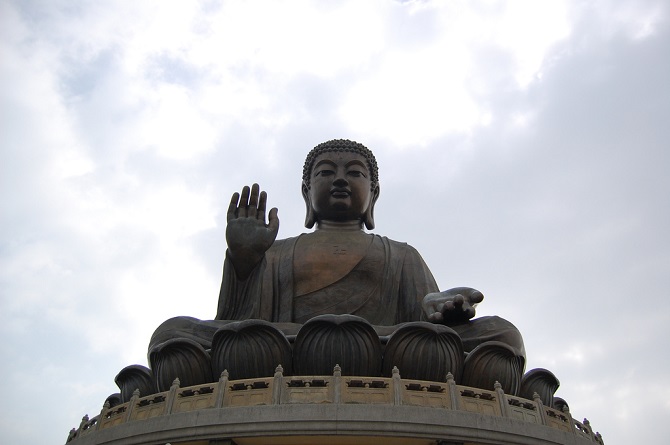
Location: Lantau Island, Hong Kong, China
A 34-meter tall Chinese Buddha statue
Tian Tan Buddha, also known as The Big Buddha, is famed as the most iconic attraction and the major center of Buddhism in Hong Kong. The statue's base is a model of the Altar of Heaven so that it is named Tian Tan Buddha. This Chinese Buddha statue is sited near Po Lin Monastery.
Learn more here:
- Information about Tian Tan Buddha: Po Lin Monastery
Mengshan Giant Buddha (蒙山大佛)
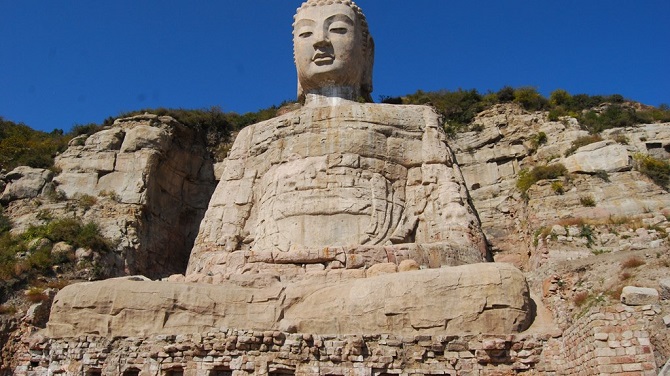
Location: Taiyuan, Shanxi, China
A 63-meter tall Chinese Buddha statue
The Mengshan Giant Buddha, also known as the Western Hills Giant Buddha. It is a stone Chinese Buddha statue located in the city of Taiyuan. It was built in The Northern Qi Dynasty, and now is the relic protection unit of Taiyuan.
Spring Temple Buddha (中原大佛)
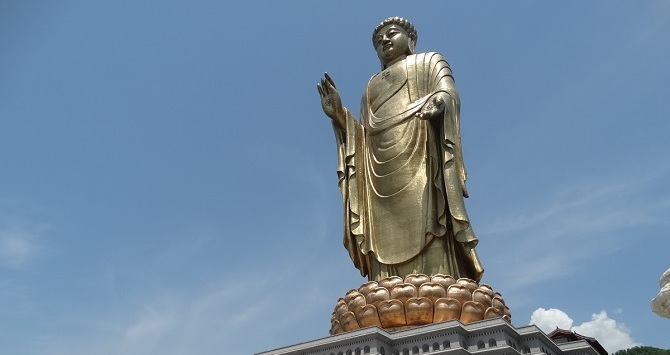
Location: Lushan, Henan, China
A 128-meter tall Chinese Buddha statue
The Spring Temple Buddha was built from 1997 to 2008. It was designed by Lin Shengbiao, the vice president of the Fujian Arts and Crafts Masters Association. It is a giant Chinese Buddha statue located in the Fodushan Scenic Area in the Zhaocun township of Lushan.
Lingshan Giant Buddha (靈山大佛)

Location: Wuxi, Jiangsu, China
A 88-meter tall Chinese Buddha statue
Lingshan Giant Buddha or Lingshan Buddha, is one of the symbol of Wuxi City located at the northern bank of Taihu Lake. The construction of Lingshan Grand Buddha was host by Zhao Puchu, the former chairman of the Buddhist Association of China. This Chinese Buddha statue was completed at 1996.
Guanyin of Nanshan (南山海上觀音)
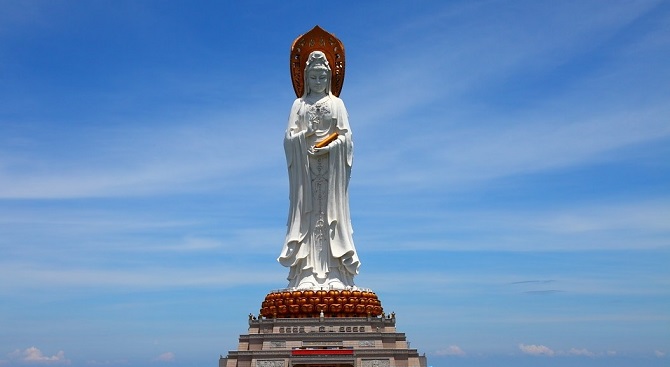
Location: Sanya, Hainan, China
A 108-meter tall Chinese Buddha statue
The Guanyin of Nanshan is a statue of the bodhisattva Guanyin located on Hainan near the Nanshan Temple of Sanya. The statue has three aspects and represents blessing and protection by Guanyin. Zhao Puchu, who is the former chairman of the Buddhist Association of China, selected Hainan as the location for building this Guanyin statue.
Chinese Buddhist Grottoes
China has many large and richly endowed treasure houses of Buddhist art. These Buddhist grottoes consist of many ancient Buddhist sculptures and are also the popular tourist attractions. If you are going to travel to China, these places are also the good choices for visiting.
Mogao Caves (莫高窟)
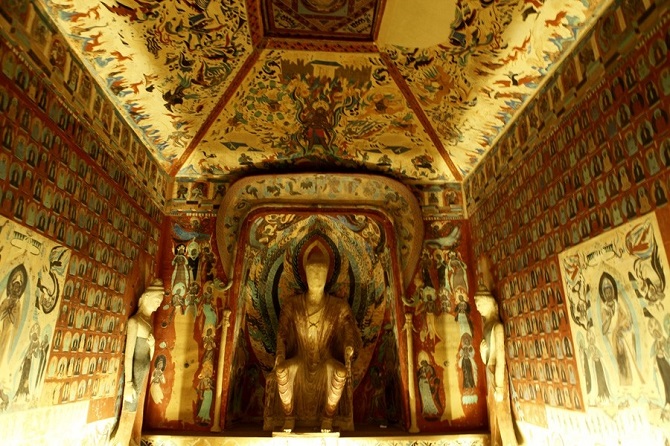
Location: Dunhuang, Gansu, China
Start Building from The Former Qin Dynasty (351-394 AD)
The Mogao Caves, also has other names, including the Thousand Buddha Grottoes or Caves of the Thousand Buddhas. In 1987, the site was inscribed upon the UNESCO World Heritage List. Mogao Caves consists of 750 caves, over 490 of them with mural paintings such as paradise, and angels, on five levels hewn into an escarpment in the desert. You can discover more than 2000 painted clay figures and Buddha figurines in Mogao Caves.
Learn more here:
- Mogao Caves images: Digital Dunhuang
- Information about Mogao Caves: World Heritage Convention
Longmen Grottoes (龍門石窟)
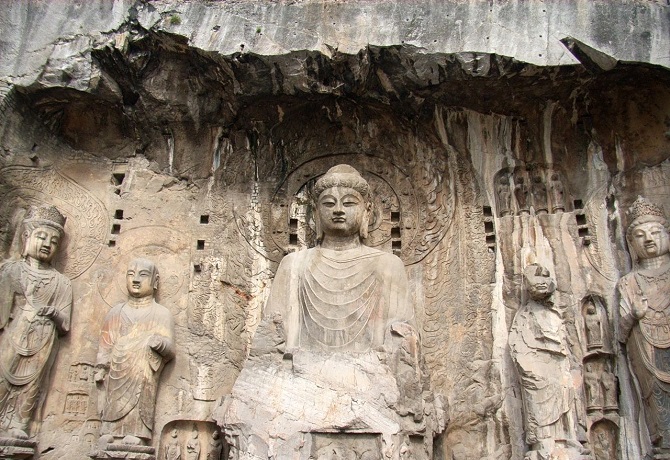
Location: Luoyang, Henan, China
Start Building from The Northern Wei Dynasty (386-535 AD)
The Longmen Grottoes, also known as the Longmen Caves or Dragon's Gate Grottoes. In Longmen Grottoes, we can discover over 2000 holes and niches, 1000 caves, 40 dagobas, 2000 steles, and 100000 statues. It became one of the UNESCO World Heritage Sites in 2000, and was described as “an outstanding manifestation of human artistic creativity”.
Learn more here:
- Information about Longmen Grottoes: World Heritage Convention
Yungang Grottoes (雲岡石窟)
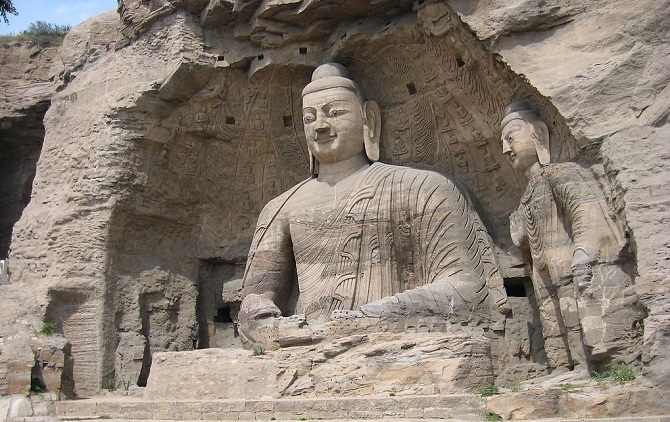
Location: Datong, Shanxi, China
Start Building from The Northern Wei Dynasty (386-535 AD)
The Yungang Grottoes is one of the three most famous ancient Buddhist sculptural sites of China. Yungang Grottoes consists of over 40 major caves, 200 shrines, and 50000 sculptures, which is known as the world-famous stone carving art and one of the largest grotto groups in China. In 2001, Yungang Grottoes became one of the UNESCO World Heritage Sites.
Learn more here:
- Information about Yungang Grottoes: World Heritage Convention
Maijishan Grottoes (麥積山石窟)
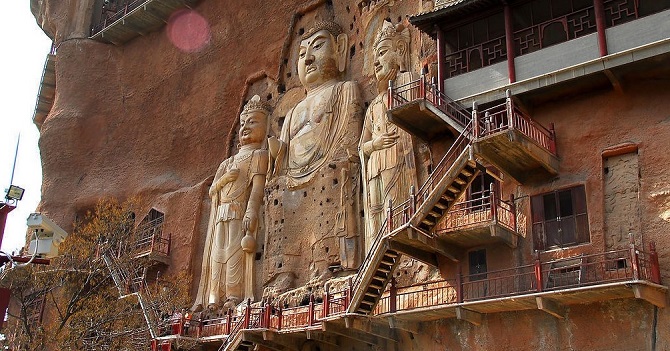
Location: Tianshui, Gansu, China
Start Building from The Northern Wei Dynasty (386-535 AD)
The Maijishan Grottoes was inscribed upon the UNESCO World Heritage List. It is a series of about 190 caves carved into the nearly sheer face of a sandstone mountain. Maijishan Grottoes hold over 7000 Buddha statues, you can note the significant variation between the statues.
Learn more here:
- Information about Maijishan Grottoes: World Heritage Convention
Dazu Rock Carvings (大足石刻)
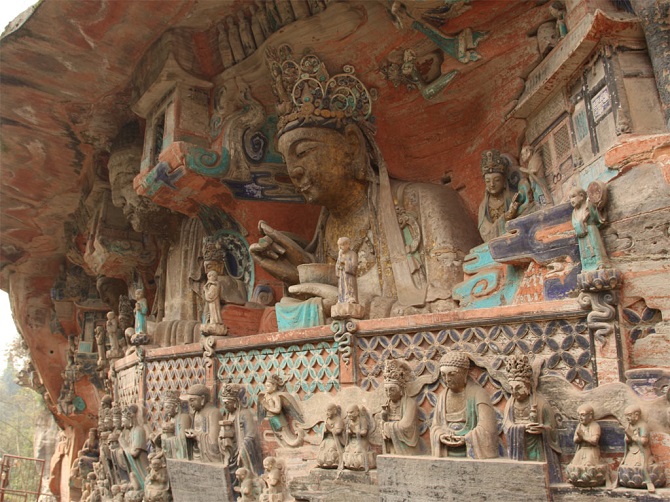
Location: Dazu, Chongqing, China
Start Building from The Tang Dynasty (618-907 AD)
As the World Culture Heritage in Chongqing, The Dazu Rock Carvings is comprised of the cliffside carvings at Shizhuanshan, Beishan, Nanshan, Baodingshan, and Shimenshan. There are over 10000 carvings related to the theme of Tantric Buddhism and Taoism, which were created from 9th to 12th century.
Learn more here:
- Information about Dazu Rock Carvings: World Heritage Convention
Xumishan Grottoes (須彌山石窟)

Location: Guyuan, Ningxia Hui Autonomous Region, China
Start Building from The Northern Wei Dynasty (368-534 AD)
The Xumishan Grottoes is one of the national relic protection units. There are over 130 grottoes mainly distributed in 8 different cliffs. Different grottoes excavated from The Northern Wei, Sui and Tang dynasties in Xumishan show a different style of different age. The site has been subdivided into 5 scenic sites: Dafo Tower, Zisun Palace and Yuanguang Temple, Xiangguo Temple and Taohua Cave. You can find many statues, wall paintings, and inscribed stelae here.
Bingling Temple Grottoes (炳靈寺石窟)
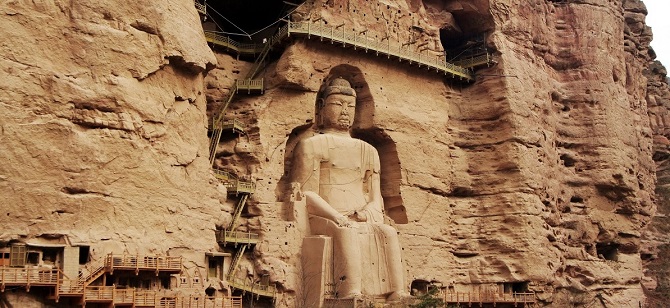
Location: Yongjing, Gansu, China
Start Building from The Western Qin Dynasty (385-431 AD)
The Bingling Temple Grottoes were built on a large scale, including over 180 caves or niches, 80 clay sculptures, 60 stone sculptures, and a lot of wall paintings. Apart from that, Bingling Temple Grottoes is preserving the earliest inscriptions among the Chinese Buddhist Grottoes.
Yulin Grottoes (榆林窟)
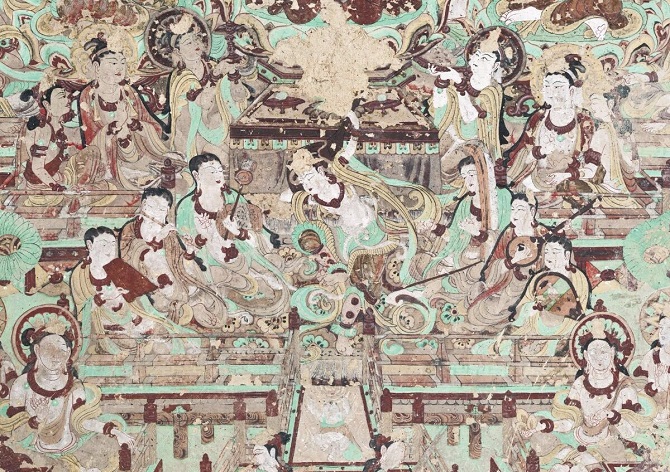
Location: Guazhou, Gansu, China
Start Building from The Northern Wei Dynasty (368-534 AD)
The Yulin Grottoes has over 40 caves with complete frescoes, comprising of huge scripture drawings, portraits of Buddha, rare animals and plants, harvests, weddings, banquets, chess, brewing, music, and dancing. in addition, there are 25 caves of Tang murals among these grottoes.
Tiantishan Grottoes (天梯山石窟)
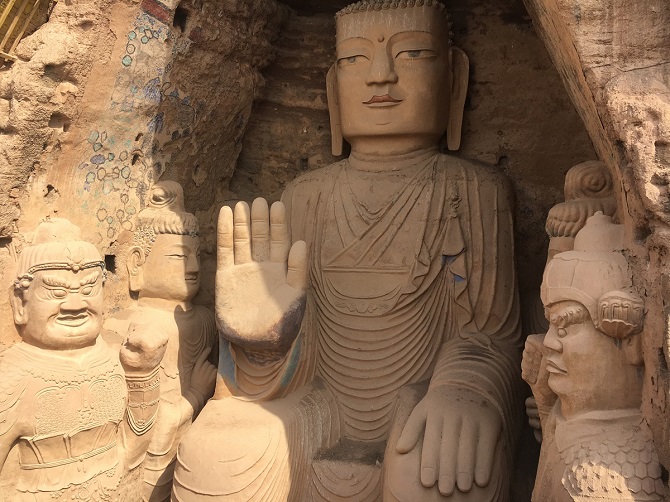
Location: Wuwei, Gansu, China
Start Building from The Northern Liang Dynasty (397-439 AD)
The Tiantishan Grottoes, a famous site well known for its historical status in the spread of Buddhism art in ancient China. It was built in the Northern Liang Period, with a history of about 1600 years. You can discover the murals for hundreds of square meters in the grottoes. Tiantishan Grottoes hold over 100 Buddha statues, and the Buddhist texts of Wei, Sui, and Tang dynasties.
If you like this page or wanna support us to promote Buddhism, you are welcome to buy us a coffee.
Last Update: 17/11/2022










